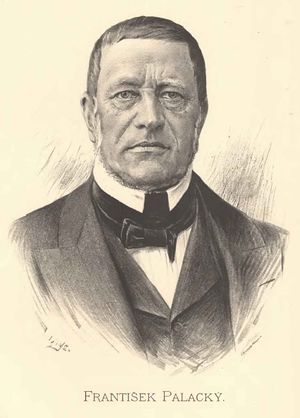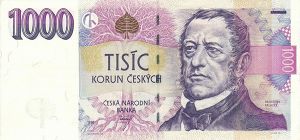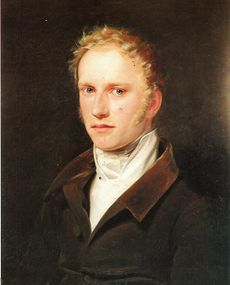فرانتيشك پالاتسكي
فرانتيشك پالاتسكي František Palacký | |
|---|---|
 | |
| MP of Bohemian provincial diet | |
| في المنصب 1861–1876 | |
| MP of Imperial Diet | |
| في المنصب 1848–1849 | |
| تفاصيل شخصية | |
| وُلِد | يونيو 14, 1798 هولدسلاڤيتسه، ملكية هابسبورگ |
| توفي | مايو 26, 1876 (aged 77) پراگ, النمسا-المجر |
| القومية | تشيكي |
| الحزب | الحزب التشيكي القديم |
| الأنجال | Jan Křtitel Kašpar Palacký Marie Riegrová-Palacká |
| المهنة | Politician Historian |
فرانتيشك پالاتسكي (František Palacký ؛ النطق التشيكي: [ˈfraɲcɪʃɛk ˈpalatskiː]؛ 14 يونيو 1798 – 26 مايو 1876) كان مؤرخ وسياسي تشيكي، والشخص الأكثر تأثيراً في الإحياء الوطني التشيكي، ويُطلق عليه "أبو الأمة".[1]
. . . . . . . . . . . . . . . . . . . . . . . . . . . . . . . . . . . . . . . . . . . . . . . . . . . . . . . . . . . . . . . . . . . . . . . . . . . . . . . . . . . . . . . . . . . . . . . . . . . . . . . . . . . . . . . . . . . . . . . . . . . . . . . . . . . . . . . . . . . . . . . . . . . . . . . . . . . . . . . . . . . . . . . .
سيرته
وُلِد فرانتيشك پالاتسكي في شرق موراڤيا بقرية هولدسلاڤيتسه، التي هي اليوم جزء من Moravian-Silesian Region في جمهورية التشيك. His ancestors had been members of the community of the Bohemian Brethren, and had clandestinely maintained their Protestant belief throughout the period of religious persecution, eventually giving their adherence to the Augsburg confession as approximate to their original faith. Palacký's father was a schoolmaster and a man of some learning. The son was sent in 1812 to the Evangelic Lutheran Lyceum في مدينة براتيسلاڤا، التي كانت آنذاك مجرية، where he came in contact with the philologist Pavel J. Šafařík and became a zealous student of Slavic languages (he mastered 11 languages and became familiar with a few others).
ذكراه

Palacký is considered as one of the three Fathers of the nation – the first being the King of Bohemia and Holy Roman Emperor Charles IV, the second is František Palacký and the third is President of Czechoslovakia Tomáš Garrigue Masaryk. Various individuals like to emphasize one over the other. As to historians, none have surpassed his history of Bohemia except when they have focused on a narrower time period.[بحاجة لمصدر] Even these have been directly or indirectly influenced by his work.
أعماله
الشعر
- Na horu Radhošť – poem
- Má modlitba dne 26. července 1818 – hymnus
- Ideál říše – ode from year 1920
أعمال أخرى
- Würdigung der alten böhmischen Geschichtschreiber (Prague, 1830), dealing with authors of many of whose works were then inaccessible to Czech students
- Dějiny národu českého v Čechách a v Moravě I–V ("The History of the Czech Nation in Bohemia and Moravia"), 1836–1867
- Archiv český (6 vols., Prague, 1840–1872)
- Urkundliche Beiträge zur Geschichte des Hussitenkriegs (2 vols., Prague, 1872–1874)
- Documenta magistri Johannis Hus vitam, doctrinam, causant ... illustrantia (Prague, 1869)
- with Šafařík he wrote Anfänge der böhmischen Dichtkunst (Pressburg, 1818) and Die ältesten Denkmäler der böhmischen Sprache (Prague, 1840)
- Three volumes of his Czech articles and essays were published as Radhost (3 vols., Prague, 1871–1873)
انظر أيضاً
المراجع
- ^ Baar, 2010
للاستزادة
- Baar, Monika. Historians and Nationalism: East-Central Europe in the Nineteenth Century (2010) excerpt, pp 29–34 and passim
- This article incorporates text from a publication now in the public domain: Chisholm, Hugh, ed. (1911). . دائرة المعارف البريطانية. Vol. 20 (eleventh ed.). Cambridge University Press. p. 523.
{{cite encyclopedia}}: Cite has empty unknown parameter:|coauthors=(help)
وصلات خارجية
- Pages using infobox officeholder with unknown parameters
- Articles with unsourced statements from March 2009
- مقالات المعرفة المحتوية على معلومات من دائرة المعارف البريطانية طبعة 1911
- Wikipedia articles incorporating text from the 1911 Encyclopædia Britannica
- فرانتيشك پالاتسكي
- مواليد 1798
- وفيات 1876
- People from Nový Jičín District
- أشخاص من مارگراڤية موراڤيا
- پروتستانت تشيك
- كتاب تشيك
- مؤرخون تشيك
- سياسيون تشيك
- فلاسفة تشيك
- أشخاص في ثورات 1848
- سياسيو الامبراطورية النمساوية
- أعضاء مراسلون في أكاديمية العلوم بسانت پطرسبورگ
- ملكيون تشيك
